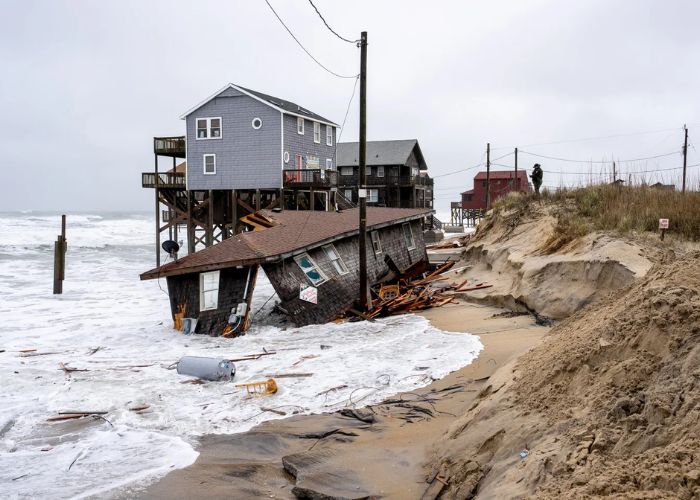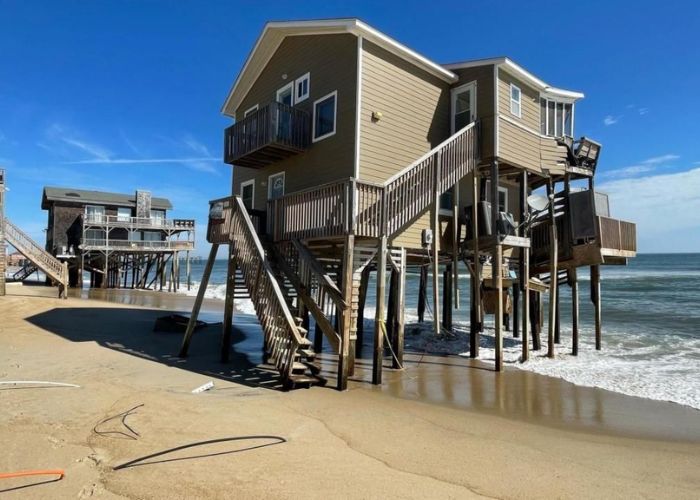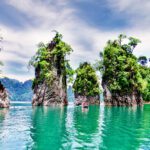As someone who loves the beach and being outside and has spent more than seven years exploring North Carolina’s beautiful coasts, it breaks my heart to see how rising sea levels are affecting the famous Outer Banks region more and more. Climate change is making this popular vacation spot more likely to flood and lose its beaches. It is known for its beautiful beaches, cute seaside towns, and lots of wildlife. Last time I went to the Outer Banks, it was this summer, and I saw directly how homes are being destroyed by the slowly rising ocean. Read below about “Rising Sea Levels Claim More Homes in North Carolina’s Outer Banks.
Table of Contents
Witnessing the Impact of Rising Sea Levels
I was struck by the sight of several houses perched dangerously close to the edge of the beach as I drove down the main road that goes through the Outer Banks. A lot of them had fences or other hurdles built along the sides that faced the beach. It was clear that these were put up as a last line of defense against the waves. They were strong, but not strong enough to stop the strong waves caused by recent storms and high tides. I saw foundations and stairs that led to nothing but air where houses had already been washed away by the sea in some cases. People in the area I talked to were sad that their friends’ homes had been destroyed and worried that their own homes might be next.
Vanishing Shoreline of Rodanthe
In the town of Rodanthe, where I saw this most clearly, a whole row of waterfront homes had disappeared. There were only empty spots of sand and some broken things left. A few years ago, these were high-end tourist homes with wide views of the ocean. Now, their damaged roads led only to the surf, which was getting closer and closer. People who know the area well told me that this neighborhood used to go three times as far out to the water. But recent storms and an estimated 3 feet of sea level rise in the last 100 years have made this once-beautiful place unlivable.
Seeing these kinds of human changes really made me realize how quickly the Outer Banks shoreline is disappearing. Some places have lost more than 1,000 feet of beach in the last 150 years. It’s been even worse for some border islands, which have lost up to 80% of their dry land area to rising seas. Scientists think that this loss will get worse as climate change speeds up. The ocean could rise another 2 to 4 feet by 2100, which would destroy even more of this fragile group of islands.
The Impact on Wildlife and Ecosystems

As a nature fan, it breaks my heart to see that the Outer Banks’ diverse ecosystems are also in danger. There are special maritime forests, salt marshes, and bird refuges on these barrier islands that depend on the delicate balance of these changing environments. The Cape Hatteras National Seashore piping plover and many sea turtles are already in danger because of beach erosion, and they could lose even more important places to nest. There is a chance that whole islands and inlets that protect fragile marshes will flood and disappear.
The way people have responded to this environmental disaster so far has been all over the place. To deal with higher seas, some homes and buildings have been strengthened or put on pilings to raise them. However, this is expensive and won’t work forever. In other places, people are using nature to fight back against higher tides by rebuilding beaches and restoring natural dunes that protect them. But maybe the most common thing people do is just move their homes, businesses, and facilities further inland as the erosion keeps going.
Seeing the ruins of those long-gone Rodanthe homes makes me think about how hard that decision must be for people who live on the Outer Banks. For many, these houses are a part of their family vacation memories, sense of community, and sense of who they are. There are a lot of emotional and financial costs that come with leaving your land to the sea. But the truth is that some kind of pullback might be necessary to protect both people and the fragile coastal environment. Other reactions, like building seawalls or structures to stop erosion, often make things worse instead of better.
The Outer Banks and the Sea Level Rising
Because our environment is still changing, other coastal areas should learn from the Outer Banks. To find a balance, it will be important to plan ahead and protect environment. Things aren’t easy when your home is in the way of a rising sea, though. After seeing the effects for myself on my recent trip, I have a better idea of how big this problem is. I also hope that more people know about and support places like the Outer Banks, which are in danger, which will make the change to a more sustainable future along our shorelines easier.
Even though there are still big problems, I still have hope for the Outer Banks. The strong, nature-loving people who live here are the only ones who can change and keep what makes this place so special. As someone who loves being outside, I know I’ll keep going to the Outer Banks and enjoying their natural beauty for years to come. But I’ll do it now with a deeper understanding of how fragile this coastline’s beauty is, and a promise to keep places like this safe for future generations. The world is changing quickly, but we can still keep the kindness spirit alive if we all work together.
Conclusion
The Outer Banks used to be a beautiful seaside paradise, but now climate change is making things very hard. Coastal erosion and rising sea levels are very bad for the nature and the people who live there.
Even though there are a lot of problems, we need to protect the Outer Banks by taking action. This includes protecting habitats, making sure infrastructure can change, and making sure communities are strong. We can make sure that this famous area stays around for a long time and keep its natural beauty for future generations if we all work together.unities like the Outer Banks for decades to come. I hope you like reading “Rising Sea Levels Claim More Homes in North Carolina’s Outer Banks”.

Sophie Turner is the adventure travel writer behind AdventureTravelFam.com. With over 10 years of experience in travel writing and a Master’s degree in Tourism Management, Sophie shares her expertise in exploring unique destinations and providing family-friendly travel tips. Follow her adventures on Instagram @adventure_travelfamily.





